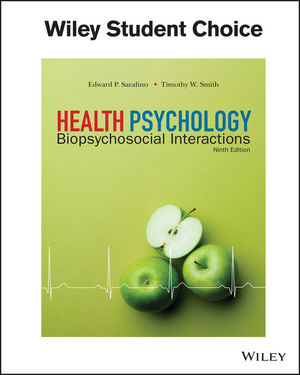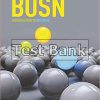Test Bank for Health Psychology: Biopsychosocial Interactions, 9th Edition, Edward P. Sarafino Timothy W. Smith
$55.00 Original price was: $55.00.$29.99Current price is: $29.99.
Test Bank for Health Psychology: Biopsychosocial Interactions, 9th Edition, Edward P. Sarafino, Timothy W. Smith,
Instant download Test Bank for Health Psychology: Biopsychosocial Interactions, 9th Edition, Edward P. Sarafino, Timothy W. Smith, pdf docx epub after payment.

Product details:
- ISBN-10 : 1119386136
- ISBN-13 : 978-1119386131
- Author: Sarafino; W.Smith
Ed Sarafino and Timothy Smith draw from the research and theory of multiple disciplines in order to effectively demonstrate how psychology and health impact each other. The newly updated 9th Edition of Health Psychology: Biopsychsocial Interactions includes a broader picture of health psychology by presenting cross-cultural data. Furthermore, international examples are also included to further explore the psychologists perspective of health issues around the world and highlight what works in the field. The psychological research cited in the text supports a variety of behavioral, physiological, cognitive, and social/personality viewpoints. An emphasis on lifespan development in health and illness is integrated throughout the text.
Table Of Contents:
Part I An Introduction: Basic Issues and Processes 1
Chapter 1 An Overview of Psychology and Health 1
What is Health? 2
An Illness/Wellness Continuum 2
Illness Today and in the Past 2
Viewpoints from History: Physiology, Disease Processes, and the Mind 5
Early Cultures 5
Ancient Greece and Rome 5
The Middle Ages 6
The Renaissance and After 6
Seeing a Need: Psychology’s Role in Health 7
Problems in the Health Care System 7
‘‘The Person’’ in Health and Illness 8
Assess Yourself: What’s Your Lifestyle Like? 8
How the Role of Psychology Emerged 10
Health Psychology: The Profession 12
Clinical Methods and Issues: Behaviorism’s Legacy: Progress in Health Psychology’s Goals 12
Current Perspectives on Health and Illness 13
The Biopsychosocial Perspective 13
Life-Span and Gender Perspectives 16
Related Scientific Fields: Foundations and Connections for Health Psychology 17
Related Fields 17
Highlight: Related Nonpsychology Careers 18
Health and Psychology across Cultures 20
Research Methods 21
Experiments 21
Correlational Studies 23
Quasi-Experimental Studies 24
Genetics Research 26
Which Research Method is Best? 28
Chapter 2 The Body’s Physical Systems 30
Module 1: The Nervous System 31
How the Nervous System Works 31
The Central Nervous System 33
Clinical Methods and Issues: Biofeedback Treatment for Paralysis 36
The Peripheral Nervous System 36
Module 2: The Endocrine System 38
The Endocrine and Nervous Systems Working Together 38
Adrenal Glands 39
Other Glands 39
Highlight: Our Physiological Individuality 40
Module 3: The Digestive System 41
Food’s Journey through Digestive Organs 41
Using Nutrients in Metabolism 43
Assess Yourself: How Many Calories Do You Burn While Resting? 44
Module 4: The Respiratory System 44
The Respiratory Tract 44
Respiratory Function and Disorders 45
Module 5: The Cardiovascular System 46
The Heart and Blood Vessels 47
Blood Pressure 48
Blood Composition 49
Cardiovascular Disorders 50
Module 6: The Immune System 50
Antigens 51
The Organs of the Immune System 51
Soldiers of the Immune System 52
Defending the Body with an Immune Response 53
Highlight: When Immune Functions Are Absent 54
Less-Than-Optimal Defenses 55
Part II Stress, Illness, and Coping 57
Chapter 3 Stress—Its Meaning, Impact, and Sources 57
Experiencing Stress in Our Lives 58
What is Stress? 58
Appraising Events as Stressful 59
Clinical Methods and Issues: Posttraumatic Stress Disorder (PTSD) 61
Dimensions of Stress 61
Biopsychosocial Aspects of Stress 62
Biological Aspects of Stress 62
Psychosocial Aspects of Stress 65
Sources of Stress throughout Life 67
Sources within the Person 67
Sources in the Family 68
Sources in the Community and Society 71
Highlight: Gender Differences in Caregiving? 71
Highlight: Does Environmental Stress Affect Reactivity to New Stressors? 74
Measuring Stress 74
Physiological Arousal 74
Life Events 75
Daily Hassles 77
Chronic Stressors in Specific Domains 78
Can Stress Be Good for You? 78
Assess Yourself: Hassles in Your Life 78
Chapter 4 Stress, Biopsychosocial Factors, and Illness 82
Psychosocial Modifiers of Stress 83
Social Support 83
Assess Yourself: How Much Emotional Support Do
You Get? 85
A Sense of Personal Control 89
Clinical Methods and Issues: Social Support, Therapy, and Cognitive Processes 89
Personality Factors in Stress 93
Type A Behavior and Beyond 95
How Stress Affects Health 98
Stress, Behavior, and Illness 98
Stress, Physiology, and Illness 99
Psychoneuroimmunology 101
Highlight: Stress and Wound Healing 104
Psychophysiological Disorders 104
Digestive System Diseases 104
Asthma 105
Recurrent Headache 105
Other Disorders 106
Stress and Cardiovascular Disorders 106
Hypertension 106
Coronary Heart Disease 108
Highlight: Does Acculturation Increase Blood Pressure? 109
Stress and Cancer 109
Chapter 5 Coping with and Reducing Stress 112
Coping with Stress 113
What is Coping? 113
Functions and Methods of Coping 113
Assess Yourself: Your Focuses in Coping 114
Reducing the Potential for Stress 118
Enhancing Social Support 118
Highlight: Do Religiousness and Spirituality Reduce Stress and Enhance Health? 119
Managing Interpersonal Problems 120
Highlight: The Amish Way of Social Support in Bereavement 120
Improving One’s Personal Control 121
Organizing One’s World Better 121
Exercising: Links to Stress and Health 121
Preparing for Stressful Events 122
Reducing Stress Reactions: Stress Management 123
…
People also search:
|
health psychology biopsychosocial interactions 9th edition pdf free
|
health psychology biopsychosocial interactions 9th edition
health psychology: biopsychosocial interactions
Related products
Test Bank
Test Bank for Clinical Immunology and Serology A Laboratory Perspective, 3rd Edition: Stevens
Test Bank
Test Bank for Decision Support and Business Intelligence Systems, 9th Edition: Efraim Turban











